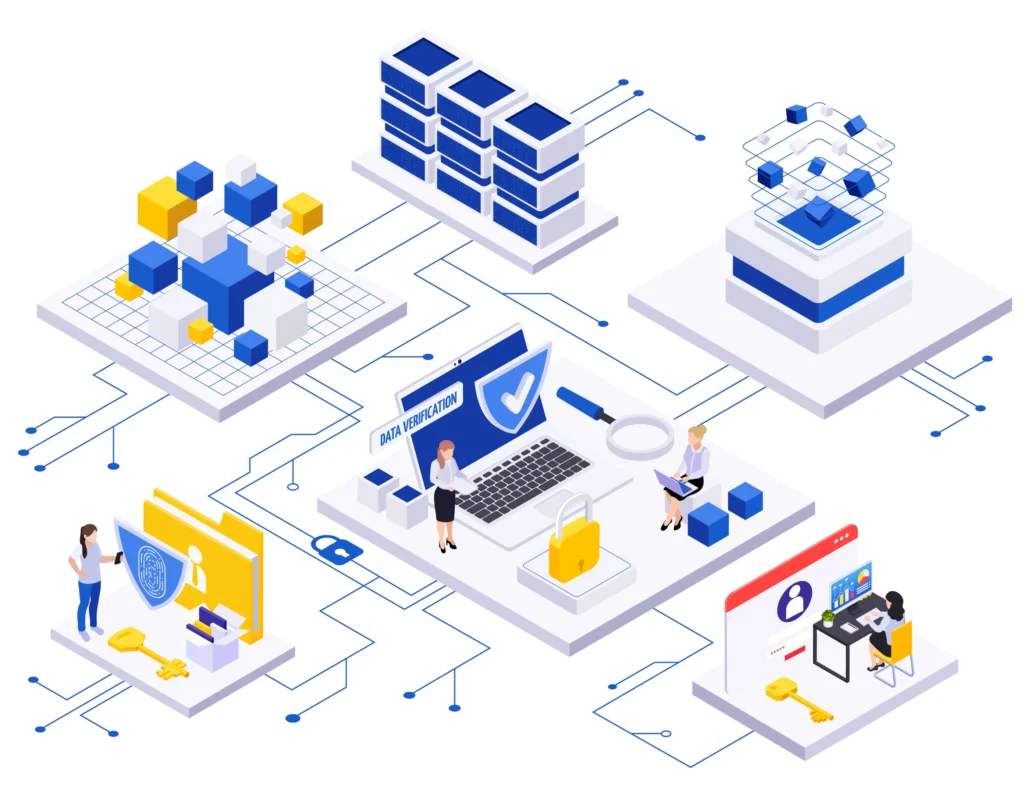
Source:Freepik
Kubernetes has conquered the container orchestration scene, empowering organizations to manage and scale their applications with unrivaled flexibility. But the story doesn’t end there. This powerful platform is constantly evolving, embracing new trends that shape its future. Join us as we explore five key areas driving Kubernetes innovation: cost optimization, edge computing, multi-cluster deployments, improved usability, and wider adoption. Along the way, we’ll delve into the crucial role of DevSecOps in securing Kubernetes deployment, ensuring your journey is both efficient and secure. So, fasten your seatbelts and prepare to navigate the exciting world of Kubernetes trends!
Understanding the Fundamentals: Cityscape to Kubernetes Cluster
Imagine your applications as buildings in a bustling city, with microservices acting as individual units. Managing them all can be chaotic. Enter Kubernetes, the city planner orchestrating the entire urban landscape.

Source: Macrovector at Freepik
The City Blocks:
Before diving into the heart of Kubernetes, let’s understand the fundamental building blocks that make it work:
- The Control Plane: Think of this as the central hub, the mastermind orchestrating everything. It manages deployments, ensures the cluster’s health, and facilitates communication between all components.
- The Worker Nodes: These are the workhorses, the individual districts within the city. They diligently run your applications, provide resources like CPU and memory, and communicate back to the control plane for instructions.
Control Plane Options:
Choosing the right control plane setup is like deciding how to manage your city:
- Single Kubernetes Control Plane: Simpler to set up and manage, with lower overhead costs. However, it’s like relying on one central authority – a single point of failure and limited scalability for larger deployments.
- Multi-Control Plane: Imagine multiple city halls, each managing specific regions. This offers high availability and scalability, but requires more complex management and specialized expertise.
Choosing Your Kubernetes Path: A Balancing Act

Source: Freepik
Selecting the right control plane approach is like choosing your city’s governance structure. Consider these key factors for a smooth Kubernetes adoption journey:
- Cluster Size: Small city, single control plane. Sprawling metropolis, multi-control plane for scalability.
- Scalability: Anticipate rapid growth? Multi-control plane scales better.
- Risk Tolerance: Single point of failure? Multi-control plane offers redundancy and minimizes downtime.
- Expertise: Multi-control plane requires more specialized knowledge.
- Budget: Initial cost lower for single, but long-term costs might be higher.
- Remember: The ideal path depends on your unique needs. Weigh these factors carefully to navigate your Kubernetes adoption journey successfully!
Kubernetes Takes Care Of Your Containerized City:
Now that you understand the city’s layout, let’s explore how Kubernetes keeps your containerized applications running smoothly:
- Deployment: Kubernetes places your containerized apps in optimal spots for efficient resource use, like finding the perfect location for each building.
- Scaling: Need more capacity? Kubernetes seamlessly adds or removes apps based on demand, adapting your city to changing needs. No more manual scaling, just smooth & automatic adjustments.
- Resource Management: Kubernetes allocates resources like CPU and memory across all your containerized applications for maximum efficiency. Every app gets what it needs, with no waste.
- Networking: Kubernetes establishes secure communication channels, enabling your containerized apps to chat safely within and beyond the city.
- High Availability: Even if buildings face issues, your city keeps running. Kubernetes ensures your apps stay resilient even with container failures. No single point of failure means your apps are always up, even if a container hiccups.
Think of Docker as the skilled builder crafting individual buildings, while Kubernetes is the city planner who orchestrates them all, providing a comprehensive management framework for your modern containerized applications.
The Rise of Key Trends

Source: Kubernetes Cluster API
Kubernetes has cemented its position as the de facto platform for container orchestration, ushering in a new era of agile, scalable application deployments. However, the landscape is constantly evolving, driven by trends that shape how organizations utilize and optimize this powerful technology. Let’s delve into six key Kubernetes trends shaping the future of Kubernetes:
1. Cost Optimization: Efficiency Reigns Supreme
With rising cloud costs, optimizing Kubernetes deployments has become a top priority. Strategies like:
- Resource Management: Granular control over resource allocation (CPU, memory) across clusters ensures efficient utilization and eliminates waste.
- Autoscaling: Dynamically scaling applications up or down based on demand prevents overprovisioning and optimizes resource usage, especially during peak loads.
- Multi-Cluster Architecture: Distributing workloads across geographically dispersed clusters can leverage cost-effective cloud regions and optimize resource utilization.
2. Edge Computing Empowered: Kubernetes at the Forefront
The rise of edge computing, processing data closer to its source, presents unique challenges. Kubernetes emerges as a powerful solution, managing workloads at the edge due to its:
- Portability and Scalability: Adapts seamlessly to diverse edge environments with varying resource constraints.
- Resilience: Ensures high availability and fault tolerance, critical for mission-critical edge deployments.
- Resource Optimization: Optimizes resource utilization on resource-constrained edge devices.
Challenges remain, such as managing network latency and security in distributed edge environments. However, ongoing development and community efforts are addressing these concerns.
3. Multi-Cluster Kubernetes: Divide and Conquer
Managing large-scale, complex deployments can be overwhelming. Multi-cluster Kubernetes tackles this by:
- Workload Isolation: Isolating workloads across independent clusters enhances security, compliance, and fault tolerance.
- Improved Performance: Distributing workloads reduces load on individual clusters, leading to faster response times and improved performance.
- Flexibility: Enables organizations to tailor cluster configurations to specific needs, catering to diverse application requirements.
However, managing and coordinating multiple clusters adds complexity. Effective tooling and automation are crucial for successful implementation.
4. Bridging the Usability Gap: From Complex to User-Friendly
While powerful, Kubernetes has a reputation for being complex to learn and manage. Efforts are underway to improve its usability with:
- Simplified Deployments: Tools and platforms offer guided deployments, reducing configuration overhead and accelerating time-to-market.
- Enhanced Management Interfaces: User-friendly dashboards and graphical interfaces simplify monitoring, troubleshooting, and configuration management.
- Pre-built Solutions: Managed Kubernetes services and pre-configured solutions provide operational simplicity for organizations lacking in-house expertise.
5. Limited Adoption: Hurdles and Solutions
Despite its advantages, Kubernetes adoption faces challenges:
- Skill Gaps: Finding skilled Kubernetes professionals can be difficult, hindering wider adoption. Training initiatives and certification programs are addressing this gap.
- Security Concerns: Securing complex Kubernetes deployments requires specialized knowledge and strong security practices. Secure by design principles and best practices are crucial.
- Integration Complexities: Integrating Kubernetes with existing infrastructure and tools can be complex. Standardization efforts and community-driven solutions are easing integration challenges.
Lorem ipsum dolor sit amet, consectetur adipiscing elit. Ut elit tellus, luctus nec ullamcorper mattis, pulvinar dapibus leo.
Addressing these challenges through education, collaboration, and readily available resources is key to unlocking the full potential of Kubernetes for a wider range of organizations.
This overview provides a glimpse into the dynamic world of Kubernetes trends. By understanding these key developments, organizations can make informed decisions about their Kubernetes journey, optimize deployments, and unlock the full potential of this transformative technology.
Securing Your Kubernetes Landscape:
Deploying Kubernetes unlocks vast possibilities, but security cannot be an afterthought. DevSecOps principles, with their emphasis on collaboration, automation, and continuous security testing, are crucial for securing your containerized environment. These principles align perfectly with central tenets of cloud-native security strategies, where security is integrated throughout the development lifecycle.

Source: Macrovector at Freepik
Key security practices like Pod Security Standards (PSPs), Network Policies, and Role-Based Access Control (RBAC) are essential for building a secure foundation. These practices align with cloud-native security best practices that prioritize granular control and least privilege, empowering you to proactively manage the unique security concerns associated with multi-cloud deployments and other cloud-native technologies.
By proactively integrating security through regular updates, vulnerability scans, and security tools, you can stay ahead of threats and address the unique security concerns highlighted by Kubernetes security incidents, including API server attacks, pod escapes, and supply chain vulnerabilities.
Embracing DevSecOps for Kubernetes Security:
- Foster cross-functional teams where developers, security professionals, and operations work together throughout the development lifecycle. This collaboration fosters a shared understanding of security risks and promotes proactive security measures.
- Automate security practices like vulnerability scanning, secure coding checks, and infrastructure-as-code validation to eliminate manual errors and streamline security processes. Automation ensures consistency and reduces the risk of human error.
- Integrate continuous security testing into every stage of the development pipeline, from code review to deployment and runtime monitoring. This continuous approach identifies and addresses security vulnerabilities early in the development process, preventing them from reaching production.
Building a Secure Foundation with Key Practices:
- Pod Security Standards (PSPs): Define resource access and security profiles for Pods, restricting privileges and preventing unauthorized actions.
- Network Policies: Control network communication within and between Pods, defining allowed traffic flows and mitigating lateral movement risks.
- Role-Based Access Control (RBAC): Implement granular access controls for users and service accounts, granting only the necessary permissions for their tasks.
- Container Image Scanning: Regularly scan container images for vulnerabilities before deployment to prevent known security risks.
- Secure Secrets Management: Use secure mechanisms like Kubernetes Secrets to store and manage sensitive data, restricting access and preventing unauthorized exposure.
Staying Ahead of Threats and Vulnerabilities:
- API Server Attacks: Keep the API Server updated and use strong authentication and authorization mechanisms to defend against attackers exploiting vulnerabilities.
- Pod Escapes: Enforce strong Pod security policies and limit container capabilities to prevent malicious actors from escaping Pods and gaining access to the host system.
- Supply Chain Attacks: Implement image scanning, enforce trusted image registries, and use secure build pipelines to mitigate vulnerabilities in container images or dependencies.
What a Kubernetes Security Incident Can Teach Us:
- Regularly update Kubernetes and container images to address known vulnerabilities.
- Conduct regular security audits and vulnerability scanning to identify and remediate security issues.
- Leverage security tools and monitoring solutions to gain visibility into cluster activity and detect suspicious behavior.
By embracing these security strategies, implementing key security practices, and staying informed about threats, you can build a robust and resilient Kubernetes landscape that protects your applications and data. Remember, security is an ongoing journey, so continuously adapt and improve your strategies to stay ahead of evolving threats.
Diving Deeper into Kubernetes Trends: Where Cloud Native is King
Dive into the hottest trends shaping Kubernetes:
- Cloud-Native Champion: Kubernetes isn’t just an orchestrator, it’s the foundation of cloud-native, with 95% of new workloads predicted to run on it by 2025.
- Multi-Cluster Mastery: Managing complex deployments across clusters? Multi-cluster is rising, offering workload isolation, improved performance, and enhanced security. Keep an eye on service meshes, overlay networks, and NFV for efficient and secure communication.
- Edge Computing Embrace: Kubernetes is adapting to edge computing, where processing power is closer to data sources. Its portability and resilience make it ideal for managing diverse edge environments, unlocking new possibilities for real-time applications and IoT deployments.
- Serverless Synergy: Serverless and Kubernetes are converging, letting developers leverage both. Deploy and manage serverless functions within Kubernetes clusters for greater flexibility and control over event-driven workloads. Specialized CNI plugins and containerization solutions are emerging to meet the demands of this integration.
- AI/ML Integration and Kubernetes Networking: Specialized CNI plugins and container solutions like Kubeflow are emerging to address the unique networking demands of AI/ML workloads within Kubernetes, highlighting a crucial aspect of Kubernetes networking trends as artificial intelligence and machine learning adoption grows.
As Kubernetes continues to shape the cloud-native landscape, mastering its trends unlocks the potential for managing containers seamlessly. By staying ahead of the curve, you’ll be equipped to navigate the ever-evolving landscape with confidence, ensuring efficient and optimized container deployments.
Conclusion: Navigating the Evolving Kubernetes Landscape with Confidence
The world of container orchestration is dynamic, and Kubernetes remains at the forefront, evolving to meet the ever-changing needs of the cloud-native landscape. We’ve explored eight key trends shaping its future, highlighting its growing influence in areas like multi-cluster deployments, edge computing, serverless integration, and AI/ML support.
While challenges exist, such as security concerns and skill gaps, the momentum behind Kubernetes is undeniable. Continuous development, a vibrant community, and a wealth of resources are fueling its growth, making it a platform with immense potential for businesses of all sizes.
Ready to embark on your Kubernetes journey? Start by exploring the resources mentioned throughout this article. Additionally, consider seeking guidance from experienced DevOps professionals and trusted partners. With the right support and resources, you can leverage the power of Kubernetes to build, manage, and scale your applications effectively.





